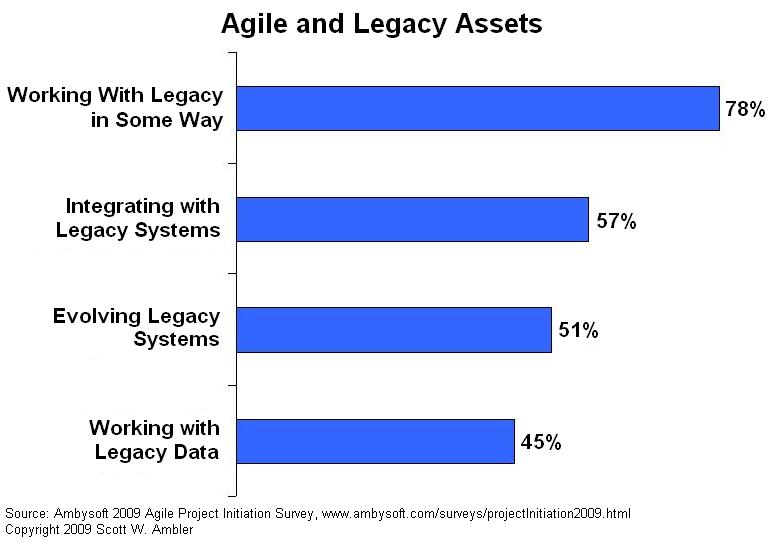Agile Project Initiation: 2009 Open Research
The Survey Results
Some findings include:
- On average, agile teams spend 3.9 weeks on project initiation efforts. See Figure 1 for details.
- 89% did some sort of up-front requirements modeling -OR- had initial requirements models given to them -OR- used reference models
- 86% did some sort of up-front architecture/design modeling -OR- had initial architecture/design models given to them -OR- used reference models
- 8% of agile teams produce no initial estimate at all, 73% create an initial high-level estimate, and 18% create an initial detailed estimate
- 8% of agile teams produce no initial schedule, 77% develop a high-level schedule, and 12% develop a detailed schedule.
- The majority of agile teams work with legacy assets in some way, see Figure 2 for details. Legacy systems analysis and legacy data analysis are apparently an important skills for agilists.
- 69% had a wide range of stakeholders
- 30% were in regulatory compliance situations
- 38% were working on mission-critical projects
- 46% were co-located in a single room
- 47% had a firm delivery date, and another 28% have promised an end date although it may change
- 56% had to produce a vision document
Figure 1. How long did it take to initiate an agile project?

Figure 2. Agile development and legacy assets..

Downloads
What You May Do With This Information
You may use this data as you see fit, but may not sell it in whole or in part. You may publish summaries of the findings, but if you do so you must reference the survey accordingly (include the name and the URL to this page). Feel free to contact me with questions. Better yet, if you publish, please let me know so I can link to your work.
Discussion of the Results
- This survey suffers from the fundamental challenges faced by all surveys.
Why Share This Much Information?
I’m sharing the results, and in particular the source data, of my surveys for several reasons:
- Other people can do a much better job of analysis than I can. If they publish online, I am more than happy to include links to their articles/papers.
- Once I’ve published my column summarizing the data in DDJ, I really don’t have any reason not to share the information.
- Too many traditionalists out there like to use the “where’s the proof” question as an excuse not to adopt agile techniques. By
providing some evidence that a wide range of organizations seem to be adopting these techniques maybe we can get them to rethink things a bit. - I think that it’s a good thing to do and I invite others to do the same.

